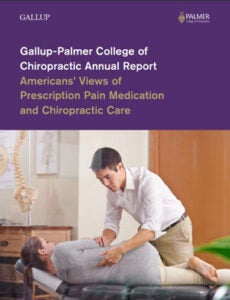Last week, President Trump stated that opioid addictions are the “worst drug crisis in history.” Chiropractic is part of the solution. As a national health emergency is declared and resources are allocated to combat the very complex issue of opioid abuse, chiropractors around the nation are raising their hands—their highly skilled and licensed hands—to say “I can help!”
Chiropractic is increasingly recognized as a safe, effective, and affordable drug-free treatment for back and neck pain. According to the Gallup-Palmer College Annual Report on Americans’ Perceptions of Chiropractic, 62 million U.S. adults (25%) went to a chiropractor in the last five years. Of those past-year chiropractic users, 95% say chiropractic was effective in treating their back or neck pain.
 People with back pain represent a significant portion of opioid users. Low-back pain is the single leading cause of physical disability worldwide, according to the Global Burden of Disease Study 2013.[1] Adults suffering from physical pain have a variety of options to address their pain — including taking prescription pain medication. But most adults in the United States say they prefer drug-free pain management. Given a choice, 78% of U.S. adults prefer to try other ways to address their physical pain before they take pain medication prescribed by a doctor.[2]
People with back pain represent a significant portion of opioid users. Low-back pain is the single leading cause of physical disability worldwide, according to the Global Burden of Disease Study 2013.[1] Adults suffering from physical pain have a variety of options to address their pain — including taking prescription pain medication. But most adults in the United States say they prefer drug-free pain management. Given a choice, 78% of U.S. adults prefer to try other ways to address their physical pain before they take pain medication prescribed by a doctor.[2]
We already have a plan of attack. Just this week, the President’s Commission on Combating Drug Addiction and the Opioid Crisis released the final draft of their report which called for calls for a nationwide system of drug courts, easier access to alternatives to opioids, and improved reimbursement for non-opioid pain treatments like chiropractic.[3] The report also reinforces the recommendations of earlier reports like the American College of Physicians guidelines for treating low back pain, published in early 2017[4], and the National Pain Strategy issued in March 2016 by the U.S. Department of Health and Human Services. [5] The Foundation for Chiropractic Progress released “Chiropractic: A Safer Strategy than Opioids,” [6] and the American Chiropractic Association also issued a policy statement on the opioid epidemic in 2016. [7]
All these publications support:
- The investigation of non-pharmacologic interventions for pain treatment across a variety of patient populations and health-care delivery settings.
- The promotion of evidence-based non-pharmacologic therapies within best practice models for pain management.
- The improvement of access to providers of non-pharmacologic therapies.
- Inter-professional education to augment the training of pain management teams.
- Public health campaigns to raise awareness of drug-free treatment options for pain syndromes.
So how can chiropractic help solve the opioid crisis? Chiropractors across the nation are ready—right now—to provide safe, effective, affordable drug-free care to patients in pain. Patients and health-care providers must choose, and sometimes demand, conservative forms of pain management like chiropractic before moving on to riskier and potentially addictive treatments such as opioids. Policy-makers must improve access to providers of non-pharmacologic therapies, and health-insurance companies must improve reimbursement for drug-free pain management options.
[1] http://www.healthdata.org/news-release/diabetes-heart-disease-and-back-pain-dominate-us-health-care-spending
[2] https://www.palmer.edu/about-palmer/palmer-publications/gallup-palmer-college-annual-report/
[3] https://www.whitehouse.gov/sites/whitehouse.gov/files/images/Final_Report_Draft_11-1-2017.pdf
[4] https://www.acponline.org/acp-newsroom/american-college-of-physicians-issues-guideline-for-treating-nonradicular-low-back-pain
[5] https://iprcc.nih.gov/sites/default/files/HHSNational_Pain_Strategy_508C.pdf
[6] http://www.f4cp.com/f4cp_opioid_white_paper.pdf
[7] http://www.acatoday.org/Patients-Why-Choose-Chiropractic-Chiropractic-and-the-Opioid-Epidemic
 People with back pain represent a significant portion of opioid users. Low-back pain is the single leading cause of physical disability worldwide, according to the Global Burden of Disease Study 2013.
People with back pain represent a significant portion of opioid users. Low-back pain is the single leading cause of physical disability worldwide, according to the Global Burden of Disease Study 2013.